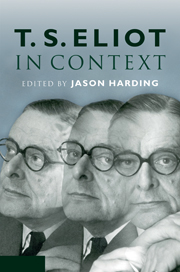Book contents
- Frontmatter
- Contents
- List of illustrations
- List of contributors
- Acknowledgements
- List of abbreviations
- Introduction
- PART ONE LIFE
- PART TWO FORMS
- 7 The role of intellectual
- 8 Publishing
- 9 Censorship
- 10 Literary journalism
- 11 Visual art
- 12 Dance
- 13 Drama
- 14 Music
- 15 Radio
- PART THREE LITERARY CROSS-CURRENTS
- PART FOUR POLITICS, SOCIETY AND CULTURE
- PART FIVE RECEPTION
- Further reading
- Index
12 - Dance
Published online by Cambridge University Press: 05 August 2012
- Frontmatter
- Contents
- List of illustrations
- List of contributors
- Acknowledgements
- List of abbreviations
- Introduction
- PART ONE LIFE
- PART TWO FORMS
- 7 The role of intellectual
- 8 Publishing
- 9 Censorship
- 10 Literary journalism
- 11 Visual art
- 12 Dance
- 13 Drama
- 14 Music
- 15 Radio
- PART THREE LITERARY CROSS-CURRENTS
- PART FOUR POLITICS, SOCIETY AND CULTURE
- PART FIVE RECEPTION
- Further reading
- Index
Summary
Dance and poetry may seem like odd bedfellows. One exists only at the ephemeral vanishing point, while the other produces timeless, unchanging artefacts. One is the silent art of the body, the other a verbal art of the mind. Yet in the first quarter of the twentieth century, dance creatively fertilised the works of several of the leading literary modernists – W. B. Yeats, D. H. Lawrence, William Carlos Williams, Hart Crane and especially T. S. Eliot. For all his reserve, Eliot was a connoisseur of dance. Revealingly, there are no beautiful female dancers adorning Eliot's poetry as figures of a unified sensibility as there are in Yeats, nor women dancing alone as an expression of psychic imbalance as there are in Lawrence's novels, nor the lusty, dancing satyrs found in Williams's poetry. Moreover, Eliot had no use for the American dancer Isadora Duncan's liberation of the female body. In his poetry, moths dance (‘The Burnt Dancer’), bears dance (‘Portrait of a Lady’) and cats dance (Old Possum's Book of Practical Cats), but when a woman dancer appears in ‘Whispers of Immortality’ she is disparagingly likened to a ‘Brazilian jaguar’ with ‘so rank a feline smell’ (CPP, 52, 53).
Yet Eliot, like many of his acquaintances in the Bloomsbury Group, was enthralled with the Russian ballet that the impresario Sergei Diaghilev brought to Europe – and for good reason.
- Type
- Chapter
- Information
- T. S. Eliot in Context , pp. 114 - 124Publisher: Cambridge University PressPrint publication year: 2011
- 1
- Cited by



